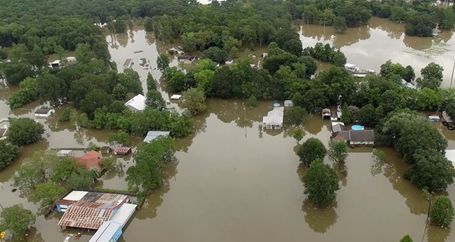"We lost pretty much everything we owned,” says Baker. “We came out with just the clothes on our backs."
— Karen Baker
Karen Baker will never forget September 26, 2015. Like a lot of moms, she was spending her Saturday shopping for back-to-school clothes for her two kids, when her cell phone rang. A neighbor was calling. "Get home now," she told Karen. “Your house is on fire."
Minutes later, Karen pulled up to her three-bedroom ranch house in Trumbull, Connecticut, and confronted a surreal scene: Fire trucks, ambulances, police cars and a swarm of neighbors all gathered in front of her smoldering home.
Fortunately, no one was home at the time and the fire, believed to have been electrical, was contained to her home office. But toxic soot particles had spread throughout the entire house, embedding every porous surface. Coupled with the mold caused by the downpour of water from fire hoses, the family suffered a total loss. And it wasn’t just the structure; the majority of her most cherished family heirlooms and mementos — old photos, antique jewelry, prized books, even the baby teeth and locks of hair she collected from her children over the years — were gone forever.
It took a year to rebuild their home. During that time, Baker thought a lot about what she could have done to better protect her family's most important and valuable possessions. Here, professional restorers and other disaster experts offer recommendations for how to protect keepsakes ahead of time — and make the right decisions about cleaning or repairing valuables if a disaster strikes.
Store valuables in high places, but not too high
In general, but especially before a flood or predicted storm, move your most important valuables above expected high water marks, and never store important items in basements or attics. "These areas are easily subjected to mold, floods, insects, mice, leaking roofs and hot temperatures that speed chemical deterioration," says Brenda Bernier, the James Needham Chief Conservator for Harvard University Library.

In general, but especially before a flood or predicted storm, move your most important valuables above expected high water marks, and never store important items in basements or attics. "These areas are easily subjected to mold, floods, insects, mice, leaking roofs and hot temperatures that speed chemical deterioration," says Brenda Bernier, the James Needham Chief Conservator for Harvard University Library.

Francis Barra and his wife, who lived in Far Rockaway, New York, when Hurricane Sandy struck, learned this lesson the hard way.
"We had all the stuff you can't replace in the basement: photos, books, marathon medals," he says. "In 15 minutes, water filled the basement to the ceiling."
These areas are also difficult to reach in the event of an immediate evacuation, which may happen in cases involving fire or tornadoes. Bernier recommends sealing paper, books and jewelry in waterproof plastic boxes or in zip-top plastic bags, both of which are easy to grab and move quickly, and storing them on higher shelves in easy-to-access bedroom or hallway closets.
Don't wrap furniture or artwork in plastic
Shelley Smith, a decorative arts and objects curator with the American Institute for Conservation of Historic and Artistic Works (AIC), advises against wrapping artwork or furniture in plastic. Mold can start forming within 24 hours of exposure to water, and plastic traps moisture. "Mold damage can be worse than if the object simply got wet and was allowed to air dry," says Smith. With large items, even if the most you can do is get them up on blocks, they may have a better chance of surviving and dry out faster.
Air might be your best friend after water damage
Because mold forms so quickly, the sooner you can safely gain access to a flooded home, the better. Immediately open doors and windows to get air circulating through the home. "If possible, spread out your valuables, bring in dehumidifiers and fans, and keep the temperature low by turning the heat down or using air conditioners," says Bernier, who notes you will need a generator to run these appliances if electricity in your area has not been restored.

Because mold forms so quickly, the sooner you can safely gain access to a flooded home, the better. Immediately open doors and windows to get air circulating through the home. "If possible, spread out your valuables, bring in dehumidifiers and fans, and keep the temperature low by turning the heat down or using air conditioners," says Bernier, who notes you will need a generator to run these appliances if electricity in your area has not been restored.

Don't stack — fan out books and papers
Soaked documents and books will probably develop water stains, but you can avoid further damage by fanning them on a table to dry. Lay papers flat; fan out the pages of books and set them upright. "When the book no longer feels damp, place it flat with weight on top to minimize warping," advises Bernier, who notes this technique does not work on books with glossy pages, which may require professional restoration. One resource Bernier recommends is the American Institute for Conservation of Historic and Artistic Works (AIC), a membership organization for professional conservators, which has an extensive list of members by region.
Never blot artwork
Do not attempt to blot dry a wet work of art, as this could damage the surface. Instead, lay it flat and let it air dry. Try to get four to eight inches of space underneath the artwork using blocks, and direct fans away from the surface. Also, don't panic if the piece has been submerged in water. AIC's Smith once recovered paintings from the walls of a room in Marfa, Texas, that had been flooded to the ceiling. "Once dry, the paintings, which were soggy, dried out nicely and required no additional work," she says.
Storage matters
Avoid storing photos and important documents in basements or attics, where conditions can speed chemical deterioration.
If you can't air-dry wet photos, put them in the freezer
Wet photos should be dried face up, with nothing stacked on top. Because this process requires an enormous amount of room, Bernier shares another option if you can't air-dry wet photos or find adequate space: freeze wet photos until you have time or space to deal with them. Individual photos can be placed in zip-top plastic bags; if you have entire boxes and albums that are wet, secure them in plastic wrap and tape any seams. When you're ready to dry the photos, defrost them in the plastic to keep them damp, then gently separate with clean fingers. For tricky separations, slip a butter knife between photos.
If your photos have dried and stuck together or are stuck to pages in a photo album, do not try to pull them apart. Bernier recommends contacting a conservator, who may be able to re-humidify or submerge them in water to separate them.
Air-dry antique furniture, wooden surfaces and jewelry
Often, in the wake of a disaster, a homeowner's first instinct might be to wipe down wet furniture, wooden floors, and metal objects or surfaces with a towel or mop after a flood or water damage. But disturbing wet surfaces can damage the varnish and cause scratches. "The least amount of physical contact, the better," says Smith.
Furniture should be air-dried, slowly and out of the sun, to help avoid warping, Smith says. Remove the drawers and items inside drawers to facilitate drying. Only attempt cleaning once the object is dry. "Using a vacuum with a HEPA filter and a soft brush to guide the dirt and debris into the nozzle," says Smith. "Avoid using vacuum attachments because they're too rough."

Often, in the wake of a disaster, a homeowner's first instinct might be to wipe down wet furniture, wooden floors, and metal objects or surfaces with a towel or mop after a flood or water damage. But disturbing wet surfaces can damage the varnish and cause scratches. "The least amount of physical contact, the better," says Smith.
Furniture should be air-dried, slowly and out of the sun, to help avoid warping, Smith says. Remove the drawers and items inside drawers to facilitate drying. Only attempt cleaning once the object is dry. "Using a vacuum with a HEPA filter and a soft brush to guide the dirt and debris into the nozzle," says Smith. "Avoid using vacuum attachments because they're too rough."

Anything metal and exposed to fresh water should be air-dried and taken to a professional cleaner or conservator, says Smith. Saltwater can corrode metal objects exposed to air, so items that have been soaking in a storm surge should be kept submerged, if possible. "Keep it wet until a conservator can desalinate it," says Smith.
Because of particulates and toxicity, Bernier says valuable fire-damaged objects should be handled by professionals. If you decide to DIY, Bernier warns against water or cleaning solutions, which can push soot deeper into the object. Instead, she recommends using specialty soot sponges, which are inexpensive and available online. "Cut them into roughly two-inch cubes so they are easier to handle and can pick up more soot," she advises.

Place water-damaged photos in a zip-top bag and freeze until you have time (and space) to thaw, separate and dry properly.
Written by
The information contained in this page is provided for general informational purposes only. The information is provided by Farmers® and while we endeavor to keep the information up to date and correct, we make no representations or warranties of any kind, express or implied, about the completeness, accuracy, reliability, suitability or availability with respect to this article or the information, products, services or related graphics, if any, contained in this article for any purpose. The information is not meant as professional or expert advice, and any reliance you place on such information is therefore strictly at your own risk.
Related articles



